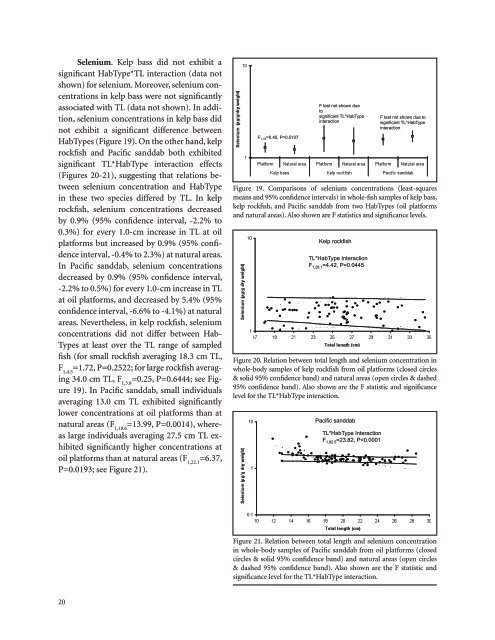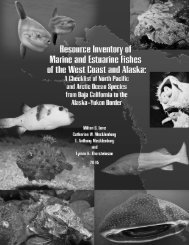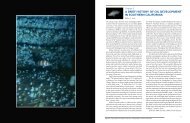Reproductive Ecology and Body Burden of Resident ... - The Love Lab
Reproductive Ecology and Body Burden of Resident ... - The Love Lab
Reproductive Ecology and Body Burden of Resident ... - The Love Lab
You also want an ePaper? Increase the reach of your titles
YUMPU automatically turns print PDFs into web optimized ePapers that Google loves.
Selenium. Kelp bass did not exhibit a<br />
significant HabType*TL interaction (data not<br />
shown) for selenium. Moreover, selenium concentrations<br />
in kelp bass were not significantly<br />
associated with TL (data not shown). In addition,<br />
selenium concentrations in kelp bass did<br />
not exhibit a significant difference between<br />
HabTypes (Figure 19). On the other h<strong>and</strong>, kelp<br />
rockfish <strong>and</strong> Pacific s<strong>and</strong>dab both exhibited<br />
significant TL*HabType interaction effects<br />
(Figures 20-21), suggesting that relations between<br />
selenium concentration <strong>and</strong> HabType<br />
in these two species differed by TL. In kelp<br />
rockfish, selenium concentrations decreased<br />
by 0.9% (95% confidence interval, -2.2% to<br />
0.3%) for every 1.0-cm increase in TL at oil<br />
platforms but increased by 0.9% (95% confidence<br />
interval, -0.4% to 2.3%) at natural areas.<br />
In Pacific s<strong>and</strong>dab, selenium concentrations<br />
decreased by 0.9% (95% confidence interval,<br />
-2.2% to 0.5%) for every 1.0-cm increase in TL<br />
at oil platforms, <strong>and</strong> decreased by 5.4% (95%<br />
confidence interval, -6.6% to -4.1%) at natural<br />
areas. Nevertheless, in kelp rockfish, selenium<br />
concentrations did not differ between Hab-<br />
Types at least over the TL range <strong>of</strong> sampled<br />
fish (for small rockfish averaging 18.3 cm TL,<br />
F 1,4.5<br />
=1.72, P=0.2522; for large rockfish averaging<br />
34.0 cm TL, F 1,3.8<br />
=0.25, P=0.6444; see Figure<br />
19). In Pacific s<strong>and</strong>dab, small individuals<br />
averaging 13.0 cm TL exhibited significantly<br />
lower concentrations at oil platforms than at<br />
natural areas (F 1,18.6<br />
=13.99, P=0.0014), whereas<br />
large individuals averaging 27.5 cm TL exhibited<br />
significantly higher concentrations at<br />
oil platforms than at natural areas (F 1,22.1<br />
=6.37,<br />
P=0.0193; see Figure 21).<br />
Selenium<br />
F 1,16 =0.45, P=0.5107<br />
F test not shown due<br />
to<br />
significant TL*HabType<br />
interaction<br />
F test not shown due to<br />
significant TL*HabType<br />
interaction<br />
Figure 19. Comparisons <strong>of</strong> selenium concentrations (least-squares<br />
means <strong>and</strong> 95% confidence intervals) in whole-fish samples <strong>of</strong> kelp bass,<br />
kelp rockfish, <strong>and</strong> Pacific s<strong>and</strong>dab from two HabTypes (oil platforms<br />
<strong>and</strong> natural areas). Also shown are F statistics <strong>and</strong> significance levels.<br />
Selenium<br />
Kelp rockfish<br />
TL*HabType Interaction<br />
F 1,28.1 =4.42, P=0.0445<br />
Figure 20. Relation between total length <strong>and</strong> selenium concentration in<br />
whole-body samples <strong>of</strong> kelp rockfish from oil platforms (closed circles<br />
& solid 95% confidence b<strong>and</strong>) <strong>and</strong> natural areas (open circles & dashed<br />
95% confidence b<strong>and</strong>). Also shown are the F statistic <strong>and</strong> significance<br />
level for the TL*HabType interaction.<br />
Pacific s<strong>and</strong>dab<br />
TL*HabType Interaction<br />
F 1,92.5 =23.82, P




